Guitar Strumming Patterns
Learn How to Play 10 Basic Strumming Patterns (Guitar Tabs and Audio Included)
In this tutorial, we're going to learn some cool strumming patterns for beginners that you can use to play many songs on your acoustic guitar.
Introduction
The term "strum" refers to a way of playing a stringed instrument using your fingers or a plectrum (pick).
This can be done with upward, downward, or a mix of strokes. Below, we will show you some specific beginner guitar strumming patterns.
However, it's not always easy to translate this into better playing.
Just because you read instructions on when to strum up and down doesn't always mean the playing will sound good.
Teaching someone how to develop rhythm is not an easy task.
Listening to your favorite guitar players and trying to internalize the beat will help. With time, practice, and patience, you'll get there. Tommy Emmanuel is a great example of how strumming can be executed with incredible skill.
One piece of advice to advance your strumming abilities: learn your chords and chord progressions.
A common pop song is often made up of three chords like G, C, and D, and then back to G. As you practice the guitar strumming patterns below, play them over chord progressions.
This will help you feel like you are playing a song, allowing you to get into the proper rhythm of strumming.
Downstrokes and Upstrokes
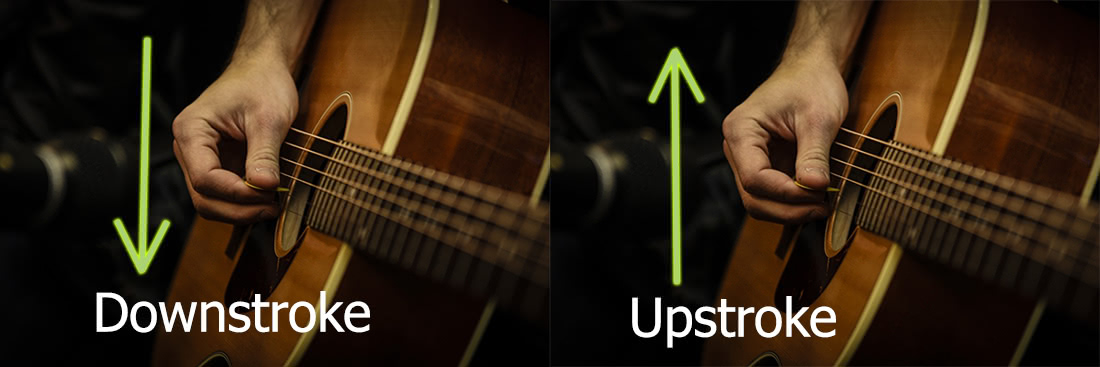
This article will primarily cover beginner downstrokes and upstrokes, which can be played with your pick.
Once you master some basic patterns, you'll be able to move on to playing with more fingerstyle techniques.
Downstrokes
The most basic strum is the downstroke, where you simply hit all the strings at once, starting from the top of the chord.
Remember, a G chord starts on the low top string, but a C starts on the next string down.
Make sure to start strumming at the bass note of the chord for a downstroke.
Don't underestimate the downstroke! It is a common feature in punk, metal, and many other styles. It is represented by a downward arrow in most guitar strumming patterns.
Upstrokes
The upstroke is the opposite of the downstroke: you start from the bottom high string and strum upwards.
Unlike the downstroke, the upstroke is rarely played alone; it's usually mixed with downstrokes.
Of course, not every strum will go from the very top to the bottom and back.
In funk music, for example, you may only play the top treble strings in the pattern.
Speaking of funk, what makes it funky is the use of sixteenth notes, while rock often relies on eighth notes.
Counting the Beat
Learning to strum also means learning how to count notes.
We won't jump into complicated patterns right away, but it is essential to learn to count the beat and use a metronome.
Don't worry if you sound robotic and lack rhythm at first—that will come with time. For now, focus on counting and strumming at the right time.
Basic Strumming Patterns to Try Out
Make sure your guitar is tuned, and select the best chords you know to play the patterns below.
Start with G, C, and D chords, as they are easy to play.
First, read the pattern, make sure you understand it, and try a dry run.
Once you have a good idea, turn on the metronome at a slow speed and start playing.
Each pattern will get progressively harder.
For each strumming pattern, we provide tabs and audio samples at 50 bpm and 100 bpm.
Pattern 1: 4 Beat Downstroke
| Beat | 1 | 2 | 3 | 4 | ||||||||||||
|---|---|---|---|---|---|---|---|---|---|---|---|---|---|---|---|---|
| Strum | D | D | D | D |
The first pattern is a simple four-beat downstroke. Simply play a downstroke on each beat of the measure.
Keep increasing your speed as you play.
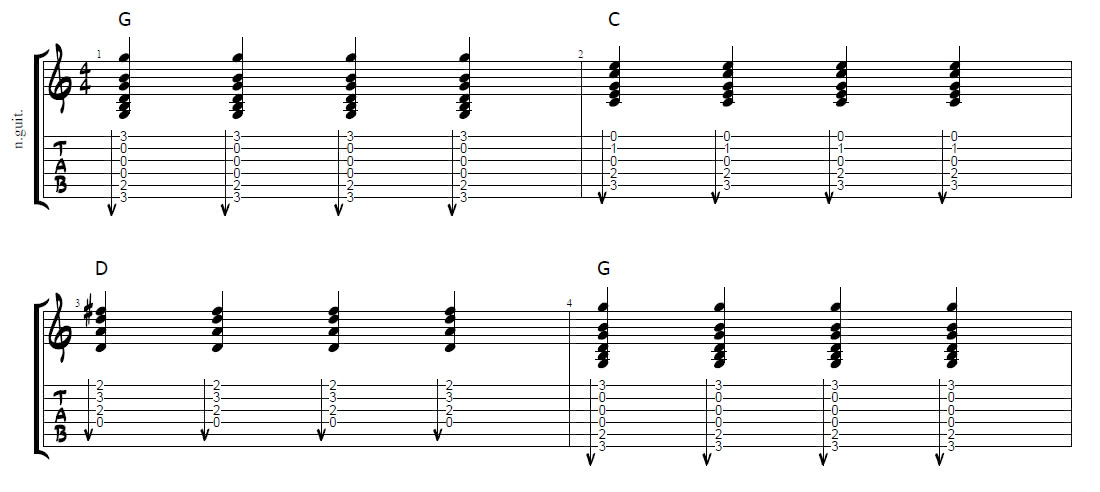
50 Bpm
100 Bpm
Pattern 2: Eighth Note Down, Up...
| Beat | 1 | 2 | 3 | 4 | ||||||||||||
|---|---|---|---|---|---|---|---|---|---|---|---|---|---|---|---|---|
| Strum | D | U | D | U | D | U | D | U |
Now a simple eighth note down, up, down, up pattern, placing the upstrokes on the 'and' of the beat.
By removing various upstrokes and downstrokes, you can create a variety of rock guitar strumming patterns.
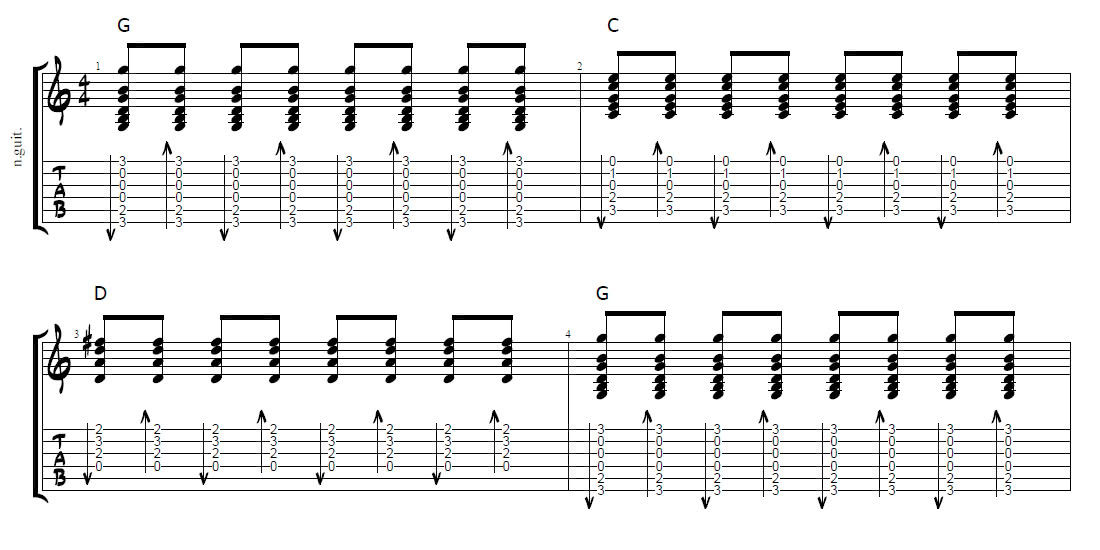
50 Bpm
100 Bpm
Pattern 3: Sixteenth Notes
| Beat | 1 | 2 | 3 | 4 | ||||||||||||
|---|---|---|---|---|---|---|---|---|---|---|---|---|---|---|---|---|
| Strum | D | U | D | U | D | U | D | U | D | U | D | U | D | U | D | U |
The next pattern may seem like a big jump, but it’s important to learn how to count sixteenth notes.
It's counted as "one-ee-and-ah-two-ee-and-ah..." and so on.
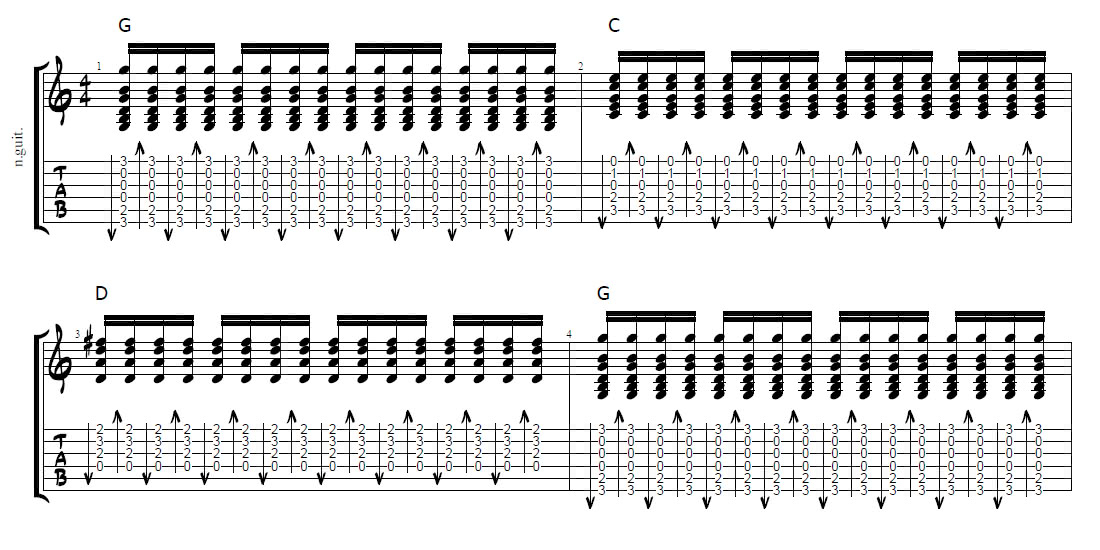
50 Bpm
100 Bpm
Pattern 4: Single Note Downstroke
| Beat | 1 | 2 | 3 | 4 | ||||||||||||
|---|---|---|---|---|---|---|---|---|---|---|---|---|---|---|---|---|
| Strum | D | D | U | D | D | U | D | D | U | D | D | U |
So far, you've just been strumming down and up, but now we'll introduce a slightly harder strum.
When you strum down on the beat, only play the low bass string.
Then, strum all the strings on the next downstroke and upstroke. This is a common strum in country and folk music.
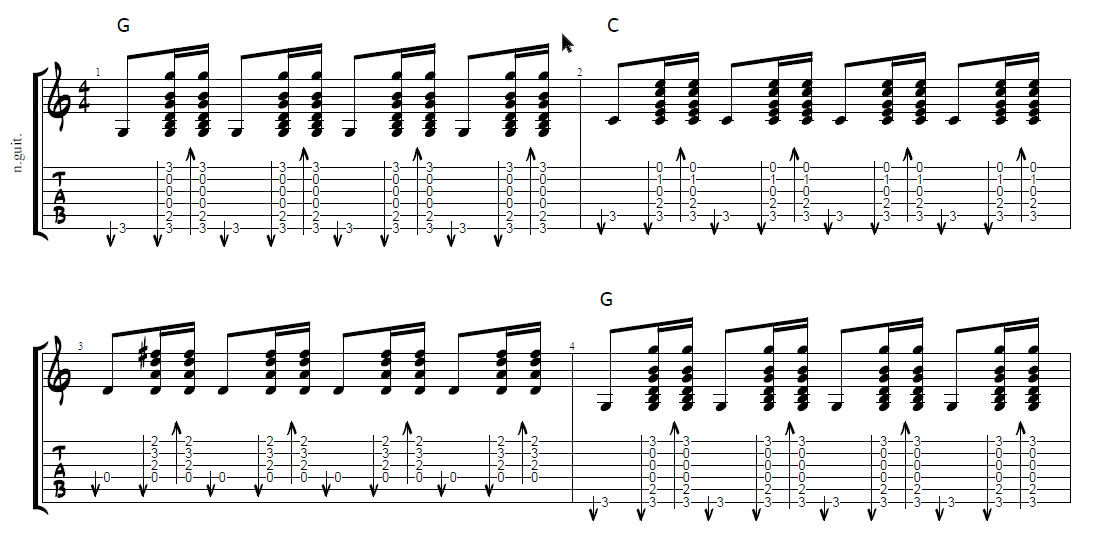
50 Bpm
100 Bpm
Pattern 5: Sixteenth Notes on Beat
| Beat | 1 | 2 | 3 | 4 | ||||||||||||
|---|---|---|---|---|---|---|---|---|---|---|---|---|---|---|---|---|
| Strum | D | U | D | D | U | D | D | U | D | D | U | D |
This next pattern plays the sixteenth notes at the start, unlike the previous pattern.
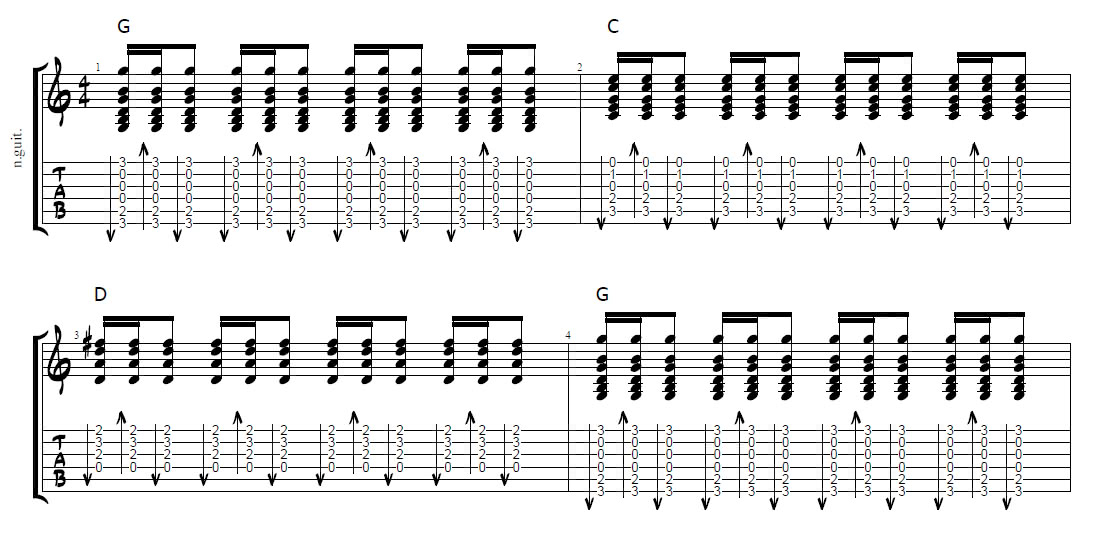
50 Bpm
100 Bpm
Pattern 6: Rock and Pop Pattern
| Beat | 1 | 2 | 3 | 4 | ||||||||||||
|---|---|---|---|---|---|---|---|---|---|---|---|---|---|---|---|---|
| Strum | D | D | U | U | D | U |
Here we return to eighth notes with this common rock and pop pattern.
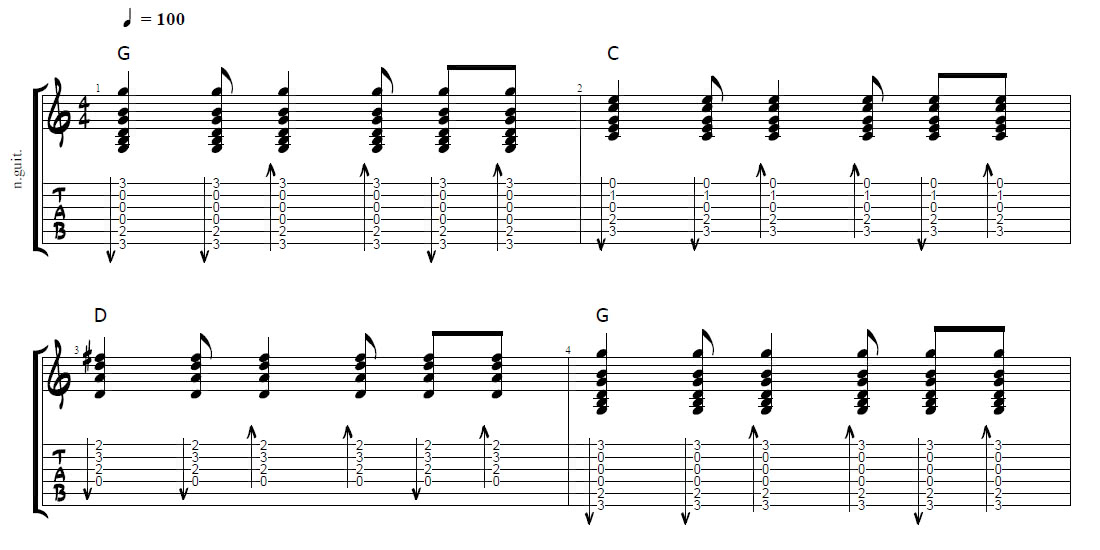
50 Bpm
100 Bpm
Pattern 7: Ska and Reggae
| Beat | 1 | 2 | 3 | 4 | ||||||||||||
|---|---|---|---|---|---|---|---|---|---|---|---|---|---|---|---|---|
| Strum | U | U | U | U | D |
Ska and reggae are defined by their offbeat rhythms, where you often don't play on the beat.
Reggae is a great genre to help you develop a sense of rhythm.
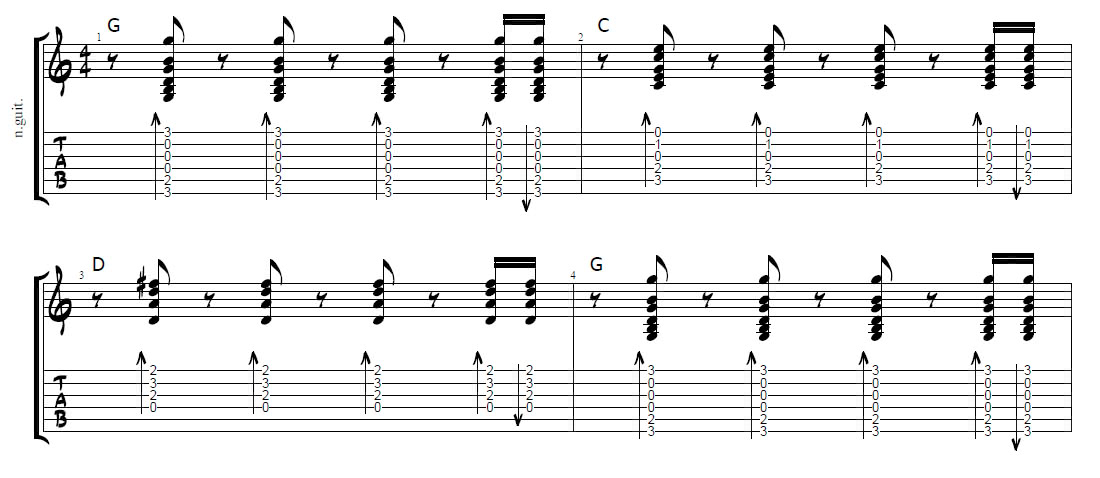
50 Bpm
100 Bpm
Pattern 8: Leaving Out the Third 'And'
| Beat | 1 | 2 | 3 | 4 | ||||||||||||
|---|---|---|---|---|---|---|---|---|---|---|---|---|---|---|---|---|
| Strum | D | U | D | U | D | U | D |
This is a very common strum pattern used in many genres. It can, of course, be varied by adding sixteenth notes if you want to spice it up.
It is very simple, but for some reason, leaving out that third 'and' really makes it powerful!
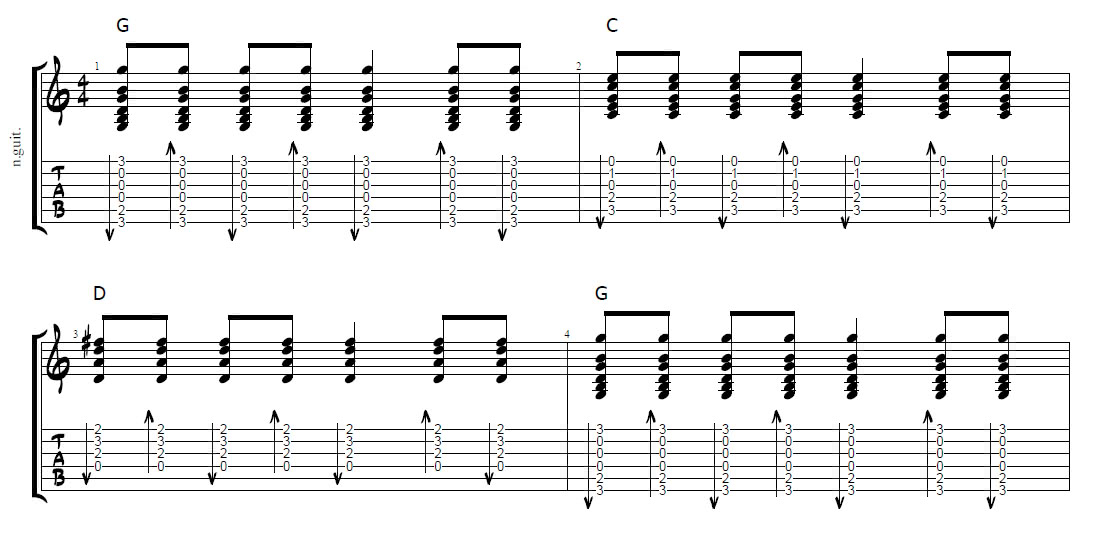
50 Bpm
100 Bpm
Pattern 9: Triplets
| Beat | 1 | 2 | 3 | 4 | ||||||||||||
|---|---|---|---|---|---|---|---|---|---|---|---|---|---|---|---|---|
| Strum | D | UDU | D | UDU |
This is a simple pattern that uses triplets. Triplets are often used in funk, which has a lot of offbeat playing.
Triplets are often played on the higher treble strings. You might also mute the strings, but that's for another article on more advanced strumming patterns.
A triplet is played as it sounds: "tr-pl-let," often using alternating strokes.
You play the chord three times (down-up-down) on one beat.
The following pattern is specifically designed to teach you some basic triplets.
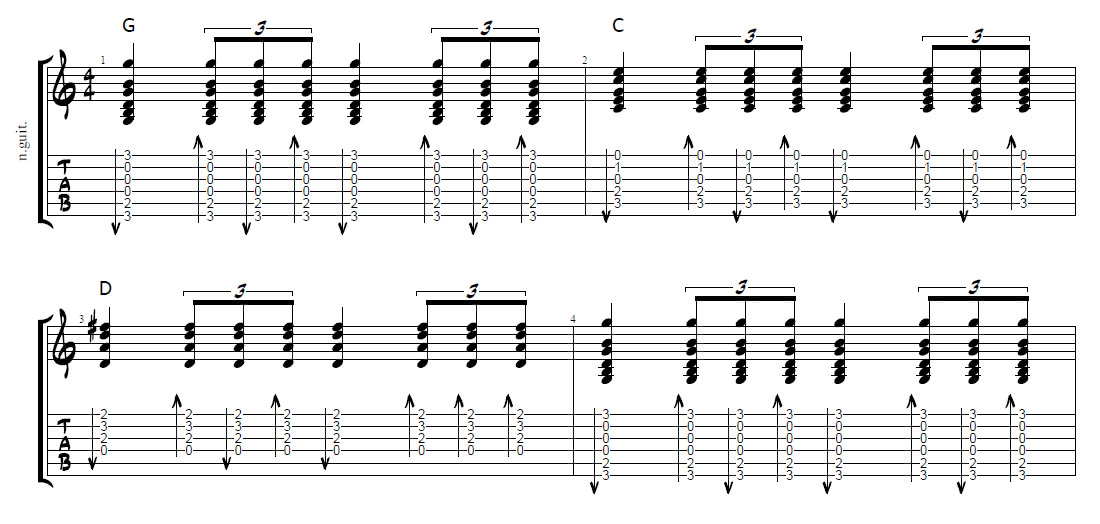
50 Bpm
100 Bpm
Pattern 10: Hard Rock
| Beat | 1 | 2 | 3 | 4 | ||||||||||||
|---|---|---|---|---|---|---|---|---|---|---|---|---|---|---|---|---|
| Strum | D | U | D | U | D | D | D | D | U | D | U | D | U |
You'll also find triplets in the metal genre, but for now, we'll stick with this well-known strum riff for those who want something heavier.

50 Bpm
100 Bpm
Strumming Patterns: Conclusion
Now that you've tried these guitar strumming patterns, keep practicing until you have them memorized.
After that, start playing faster, try harder patterns, and eventually move on to some fingerstyle patterns.
If you find it easy to memorize and play the patterns but struggle with rhythm, it's time to start playing along with some songs you like until you get the right feel.
It will happen—just keep practicing.
That's all! To stay updated on new lessons, subscribe for free here.